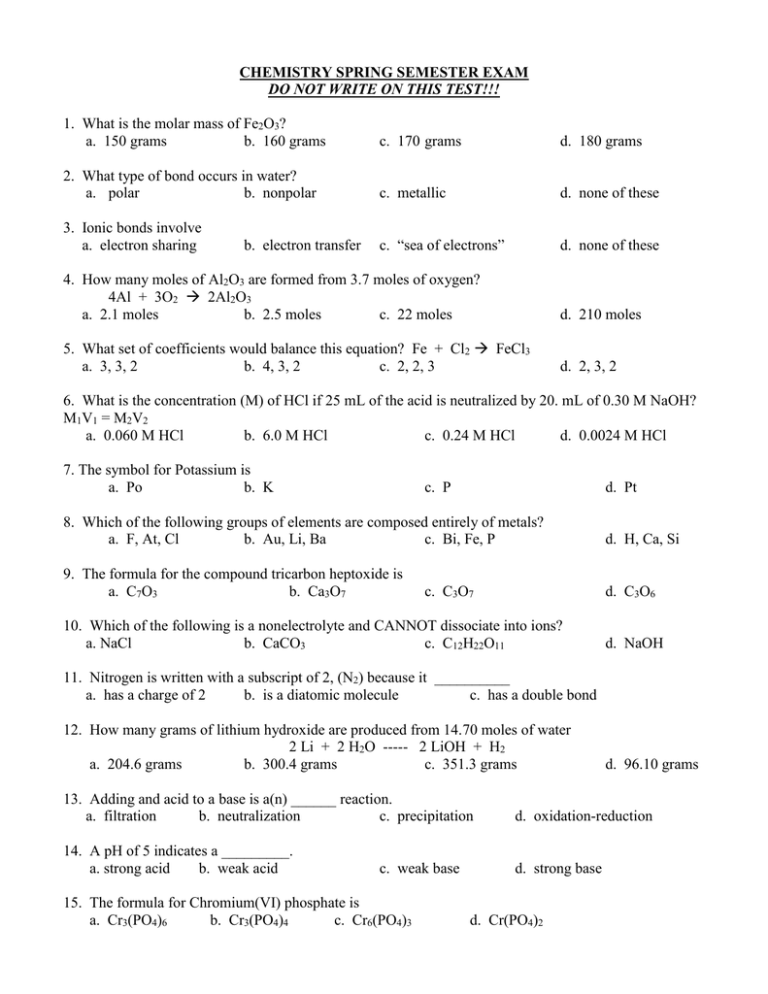Semester Review
advertisement

CHEMISTRY SPRING SEMESTER EXAM DO NOT WRITE ON THIS TEST!!! 1. What is the molar mass of Fe2O3? a. 150 grams b. 160 grams c. 170 grams d. 180 grams 2. What type of bond occurs in water? a. polar b. nonpolar c. metallic d. none of these 3. Ionic bonds involve a. electron sharing c. “sea of electrons” d. none of these b. electron transfer 4. How many moles of Al2O3 are formed from 3.7 moles of oxygen? 4Al + 3O2 2Al2O3 a. 2.1 moles b. 2.5 moles c. 22 moles d. 210 moles 5. What set of coefficients would balance this equation? Fe + Cl2 FeCl3 a. 3, 3, 2 b. 4, 3, 2 c. 2, 2, 3 d. 2, 3, 2 6. What is the concentration (M) of HCl if 25 mL of the acid is neutralized by 20. mL of 0.30 M NaOH? M1V1 = M2V2 a. 0.060 M HCl b. 6.0 M HCl c. 0.24 M HCl d. 0.0024 M HCl 7. The symbol for Potassium is a. Po b. K c. P d. Pt 8. Which of the following groups of elements are composed entirely of metals? a. F, At, Cl b. Au, Li, Ba c. Bi, Fe, P d. H, Ca, Si 9. The formula for the compound tricarbon heptoxide is a. C7O3 b. Ca3O7 d. C3O6 c. C3O7 10. Which of the following is a nonelectrolyte and CANNOT dissociate into ions? a. NaCl b. CaCO3 c. C12H22O11 d. NaOH 11. Nitrogen is written with a subscript of 2, (N2) because it __________ a. has a charge of 2 b. is a diatomic molecule c. has a double bond 12. How many grams of lithium hydroxide are produced from 14.70 moles of water 2 Li + 2 H2O ----- 2 LiOH + H2 a. 204.6 grams b. 300.4 grams c. 351.3 grams d. 96.10 grams 13. Adding and acid to a base is a(n) ______ reaction. a. filtration b. neutralization c. precipitation d. oxidation-reduction 14. A pH of 5 indicates a _________. a. strong acid b. weak acid d. strong base c. weak base 15. The formula for Chromium(VI) phosphate is a. Cr3(PO4)6 b. Cr3(PO4)4 c. Cr6(PO4)3 d. Cr(PO4)2 16. What is the correct formula for chloric acid? a. HClO3 b. HClO2 c. HClO d. HCl 17. Gallium has a molar mass of a. 31 b. 8 c. 70 d. 32 18. What can you increase to make a gas more soluble in a liquid solvent? a. particle size b. temperature c. stirring d. pressure 19. According to Boyles’ Law, if you increase the pressure on a gas the volume of the gas will ______. a. increase b. decrease c. remain constant 20. A 2.35 grams sample of carbon dioxide contains ____ molecules? a. 1.42 x 1024 b. 7.11 x 1026 c. 1.96 x 10-21 d. 3.22 x 1022 21. How many significant figures are in the measurement 7.5020 cm3? a. 6 b. 5 c. 4 d. 3 22. Choose the name-formula pair that does not correctly match. a. magnesium phosphate = Mg3(PO4)2 c. silver carbonate = AgCO3 b. iron(II) sulfite = FeSO3 d. chromium(III)dichromate = Cr2(Cr2O7)3 23. What is the subscript of aluminum in the formula aluminum sulfate? a. 1 b. 2 c. 3 d. 4 24. Which of the following compounds is soluble in water? a. MgOH b. AgCl c. KCl d. CaCO3 25. Which element has the biggest radius? a. barium b. aluminum d. helium c. chlorine 26. What coefficient should be placed before hydrosulfuric acid when the following equation is balanced? Fe2S3 + HCl FeCl3 + H2S a. 2 b. 4 c. 5 d. 6 27. In a neutralization reaction, the H+ ion from the acid and the OH- ion from the base form: a. water b. a salt c. ions 28. When using the Ideal Gas Law, the R value is based on the units of _______. a. temperature b. volume c. pressure 29. Which element will share electrons with Fluorine? a. cesium b. calcium c. cobalt d. carbon 30. Choose the correct answer. a. I LOVE CHEMISTRY! Thank goodness this test is over! I’ll now have a wonderful summer break. b. Choose a. You could get at least one question on the test right. c. Choose a. Why are you still reading the choices? The correct answer is a. d. Choose a. Choose a. Choose a. Choose a. Choose a. Choose a. Choose a. Choose a. Choose a.




